Coal [Components, Types, Uses] | Advantage & Disadvantage of Coal
What is Coal
 Coal is a flammable black or brownish-black sedimentary rock, which is usually formed in lithostrata or veins known as coal beds or coal seams. Sedimentary rocks are exposed to rising temperature and pressure to form hard forms of coal that are considered metamorphic rocks, such as anthracite. Coal is believed to be formed by the transformation of ancient plant remains buried under the ground through: peat → lignite → bituminous coal → anthracite, and anthracite can be further converted into graphite.
Coal is a flammable black or brownish-black sedimentary rock, which is usually formed in lithostrata or veins known as coal beds or coal seams. Sedimentary rocks are exposed to rising temperature and pressure to form hard forms of coal that are considered metamorphic rocks, such as anthracite. Coal is believed to be formed by the transformation of ancient plant remains buried under the ground through: peat → lignite → bituminous coal → anthracite, and anthracite can be further converted into graphite.
Coal Component
Organic matter in coal is a complex macromolecule organic compound, which is mainly composed of carbon, hydrogen, oxygen, nitrogen, sulfur and phosphorus, and the sum of carbon, hydrogen and oxygen accounts for more than 95% of organic matter. Inorganic matter in coal also contains a small amount of carbon, hydrogen, oxygen, sulfur and other elements.
Carbon is the most important component in coal, and its content increases with the deepening of coalification. The carbon content in peat is 50%-60%, lignite 60%-70%, bituminous coal 74%-92%, anthracite 90%-98%.
Sulfur is the most harmful chemical component in coal. During coal combustion, sulfur generates SO2, which pollutes the environment. So the United States has established regulations to control sulphide emissions because it is expensive to remove harmful impurities containing sulfur, so governments reward the production of low-sulfur coal to reduce pollution.
Types of Coal
According to the different carbonization degree of coal, coal is divided into peat, lignite (brown lignite, black lignite), subbituminous coal, bituminous coal (raw coal) and anthracite. The carbonization degree of anthracite is the highest and that of peat is the lowest.
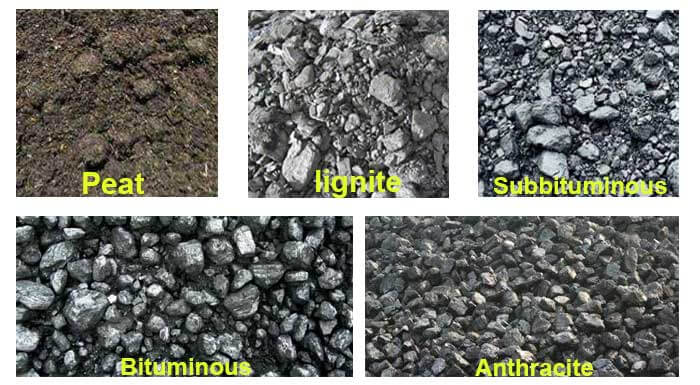
- Peat (not a coal): Peat is the coal with the lowest degree of coalification, with a carbon content of less than 60%. Peat is formed by the remains of swamp plants, which cannot be completely decomposed and accumulated under the condition of too much water and anorexia.
- lignite (brown coal): Lignite is a coal with a low degree of coalification, with a carbon content 60% – 70%. Lignite has high moisture content (15%), high volatile content (> 40%) and low ignition point (about 270℃). It is not easy to store and transport, and causes serious air pollution during combustion.
- Subbituminous (black lignite): Subbituminous coal is a transitional coal between bituminous coal and lignite, with a carbon content of 71% – 77%. The United States, Canada and China are all rich in sub-bituminous coal resources.
- Bituminous (soft coal): Bituminous coal is the product of further metamorphism of coal, with a moderate degree of coalification, with a carbon content of 77% – 87%. It emits thick smoke during combustion, so it is called bituminous coal. It is an important boiler fuel and coking raw material, and can also be used for dry distillation of petroleum and production of gas.
- Anthracite (hard coal): Anthracite is a kind of hard, dense and high-gloss coal. Among all kinds of coal, although anthracite has lower calorific value, it has the highest carbon content (> 87%) and the least impurity content. Anthracite is the highest grade coal.
How To Identify Different Coal Types
| Type | Peat | Lignite | Subbituminous | Bituminous | Anthracite |
| Color | tan, black | brown to dark brown | dark brown to black | black | grayish black |
| Luster | none | dark | bright jet-black | glossy | weak metallic |
| External Strip | native plant residue | not obvious | obvious | strip shape | no obvious strip |
| Combustion | smoke, low calorific, no caking | smoke, low calorific value, no caking | smoke, less caking | smoky, high calorific, caking | smokeless, high calorific value, no caking |
| Moisture | 70%-90% | 25%~70% | 15%-30% | 5%-20% | 5%-15% |
| Density | 0.8g/cm³ | 1.1-1.4g/cm³ | ≈1.4g/cm³ | 1.2-1.4g/cm³ | > 1.35-1g/cm³ |
| Hardness | soft, spongy | fragile | high | higher | high |
| Hydrocarbons | yes | none | none | none | none |
| Humic Acid | yes | yes | no | none | none |
Uses of Coal

Use As Fuel
Coal is used for coking and can produce coal tar and ammonia. Coke is an important raw material for ironmaking. Coal tar can extract a variety of important industrial compounds. Coal is the main fuel for heating in winter.
Coking coal
As an important raw material for ironmaking, coke plays a key role in the iron quality. The coal used for coking must be washed and selected to reduce the ash and sulfur content. Coke has high calorific value and does not smoke, it’s a good fuel.
Gasification of Coal
Coal gasification is a production process in which coal is used as raw material and a series of chemical reactions occur between organic substances and gasifier agent in coal under high temperature and pressure in a specific equipment (such as gasifier), so as to convert solid coal into combustible gas. After gasification, coal burns more fully and is more conducive to transportation and storage.
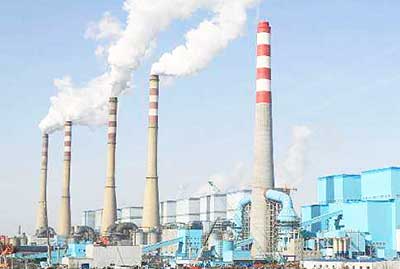
Liquefaction of Coal
Coal liquefaction is a process of converting coal into clean liquid fuel (gasoline, diesel oil and kerosene, etc.) and chemical raw materials (carbon fiber, binder, etc.) under special conditions. The liquefaction of coal helps to reduce the demand for natural oil.
Production of Chemicals
Coal is important raw material for the production of fertilizers, plastics, synthetic rubber, synthetic fibers, explosives, dyes, medicine and other important chemical raw materials, but also an important way to obtain aromatic hydrocarbons in industry.
Advantage & Disadvantage of Coal
Advantages of Coal:
- Rich in coal resources, there are coal deposits all over the world, mining and supply are very stable.
- The price is cheaper than oil and natural gas, reducing dependence on fossil fuels such as oil.
- It is not difficult to mine and utilize coal.
- Can be processed into the different form of fuel, improve combustion efficiency.
- Coal production is less dependent on the environment than natural resources such as solar energy and wind energy(24 H).
- The infrastructure for coal use is already very good.
- Coal is an important chemical raw material, such as filter materials and carbon fiber.
- The load factor of coal is more than 75%, which is more popular than wind energy and solar energy.
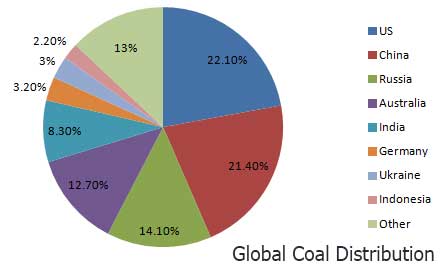
Disadvantages of Coal:
- The calorific value of coal is less than that of oil or natural gas, and the amount of carbon dioxide emitted by coal combustion is greater than that of oil and natural gas.
- Most of the mines can not be directly used after mining, so additional design of coal preparation plant or coal washing plant is required for further treatment.
- Coal combustion produces a lot of coal ash, which has radiation and increases the risk of lung cancer.
- The exploitation of coal mines has resulted in the destruction of mountains, forests and fields, destroying the balance of nature.
- Coal output is limited, it is non renewable energy.
- The output of inferior coal accounts for a large proportion, which cannot be fully burnt, and some of it is wasted.
- The coal used in thermal power plant will cause acid rain and environmental pollution without desulfurization treatment.
- Coal causes a large number of deaths every year(underground mining or coal burning).
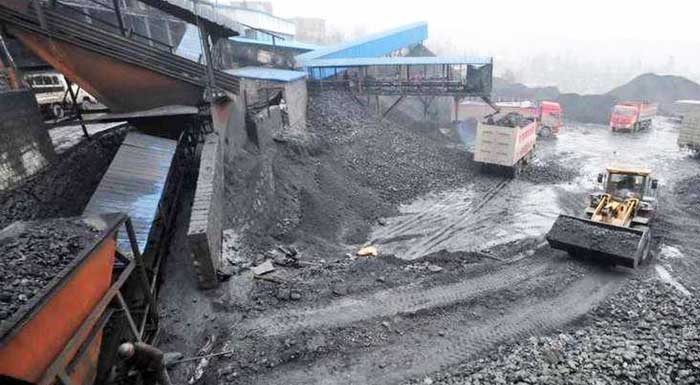 Coal Preparation Plant | Coal Preparation Process | Coal Washing
Coal Preparation Plant | Coal Preparation Process | Coal Washing 6 Hot Types Speed Reducer [Advantages & Disadvantage]
6 Hot Types Speed Reducer [Advantages & Disadvantage] Coal Dewatering Screen | Working Principle | Features
Coal Dewatering Screen | Working Principle | Features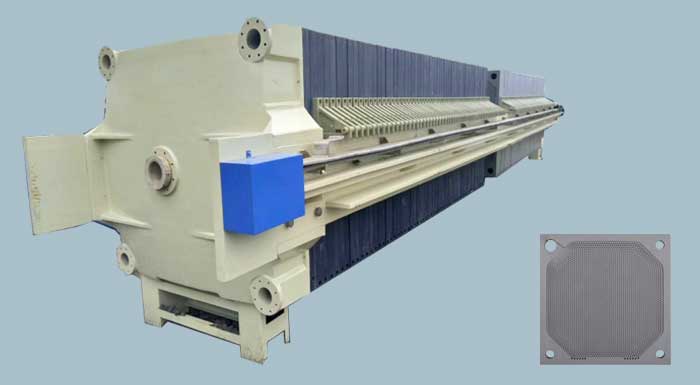 Filter Press [Definition, Components, Types & Comparison]
Filter Press [Definition, Components, Types & Comparison]

